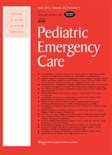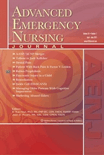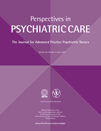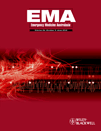
Australasian Emergency Care
Scope & Guideline
Advancing Evidence-Based Practices in Emergency Care.
Introduction
Aims and Scopes
- Emergency Nursing Practices:
Research dedicated to the practices, challenges, and innovations in emergency nursing, including education, clinical behaviors, and coping mechanisms. - Paramedicine and Prehospital Care:
Studies exploring the roles, training, and experiences of paramedics in prehospital settings, including their interactions with patients and the healthcare system. - Patient Outcomes and Safety:
Investigations into factors affecting patient outcomes in emergency departments, including quality of care, adverse events, and the impact of interventions. - Mental Health and Wellbeing in Emergency Care:
Research focusing on the psychological aspects of emergency care, including the mental health of patients and healthcare providers, and the impact of trauma and stress. - Disaster Preparedness and Response:
Studies on the preparedness of emergency services for disasters, including the effectiveness of response strategies and the impact on healthcare delivery. - Innovations in Emergency Care Delivery:
Exploration of new technologies and methodologies in emergency care, including telemedicine, simulation training, and the use of virtual reality. - Public Health and Community Engagement:
Research addressing the role of emergency care in public health, including community paramedicine and health education initiatives.
Trending and Emerging
- Telehealth and Virtual Care Innovations:
With the ongoing integration of technology in healthcare, studies exploring telehealth applications in emergency settings are on the rise, emphasizing the need for accessible care. - Mental Health and Trauma Informed Care:
An increasing focus on mental health, particularly in emergency settings, reflects a growing recognition of the psychological needs of patients and healthcare providers. - Diversity and Inclusion in Emergency Care:
Research examining the experiences of marginalized groups within emergency departments is gaining traction, highlighting the importance of culturally competent care. - Workplace Safety and Violence Prevention:
As workplace violence becomes a critical issue, studies focusing on the safety and wellbeing of emergency care providers are increasingly relevant. - Interdisciplinary Collaboration in Emergency Care:
Emerging themes emphasize the importance of collaboration among various healthcare professionals to enhance patient outcomes and streamline care processes. - Education and Training Innovations:
There is a notable increase in research regarding innovative educational strategies for emergency care providers, including simulation-based training and virtual learning.
Declining or Waning
- Traditional Emergency Medicine Protocols:
Research related to long-standing emergency medicine protocols is becoming less frequent, possibly due to the adoption of more innovative practices and guidelines. - In-hospital Emergency Management:
Although still relevant, studies specifically focused on in-hospital emergency management practices have decreased, indicating a shift towards prehospital and community-based emergency care. - Basic Life Support and CPR Techniques:
While essential, research centered on basic life support and CPR techniques is less prevalent, as the focus shifts to advanced training and technology-enhanced methods. - Generalized Patient Care Studies:
Research that broadly addresses patient care without specific focus on emergency contexts is waning, possibly due to an increased emphasis on targeted studies that address specific populations or conditions.
Similar Journals

Journal of the American College of Emergency Physicians Open
Transforming Emergency Care with Open Access ResearchJournal of the American College of Emergency Physicians Open is a prominent Open Access journal published by WILEY that has been committed to advancing the field of emergency medicine since its inception in 2020. As a vital resource for researchers, clinicians, and students, this journal aims to disseminate innovative research findings, clinical guidelines, and educational resources that support the rapidly evolving landscape of emergency care. With a solid Q1 ranking in the emergency medicine category and positioned within the top 25 ranks of Scopus’ emergency medicine listings, the journal ensures high visibility and accessibility for critical research. As an open-access publication, it provides unrestricted access to its content, facilitating knowledge sharing and collaboration among professionals globally. The journal's significant impact on the field is reflected in its growing influence, underlining its relevance as an essential platform for advancing emergency medicine practice and research.

PEDIATRIC EMERGENCY CARE
Shaping the Future of Emergency Medicine for ChildrenPediatric Emergency Care, published by Lippincott Williams & Wilkins, serves as a vital resource within the fields of Emergency Medicine, Pediatrics, and Child Health. Established in 1985, this journal offers a platform for the dissemination of impactful research, offering critical insights for healthcare professionals dedicated to improving emergency care for children. With an impressive impact factor, it ranks in the Q2 category in Emergency Medicine and Pediatrics, highlighting its significance in advancing clinical practices and outcomes. Although not an open-access journal, it provides extensive access options to ensure the research is available to a broad spectrum of readers. The journal's rigorous standards and commitment to excellence make it an essential tool for researchers, practitioners, and students aiming to stay at the forefront of pediatric emergency care advancements.

Frontiers in Emergency Medicine
Pioneering insights for the future of emergency healthcare.Frontiers in Emergency Medicine, published by Tehran University of Medical Sciences, stands as an essential open-access platform dedicated to advancing research and practice in the diverse fields of emergency medicine, nursing, and medical services. With a focus on publishing high-quality studies that address the emerging challenges in prehospital and emergency care settings, this journal has rapidly gained recognition since its inception in 2021. The journal's current Scopus rankings place it favorably within the top quartiles for emergency medical services and emergency nursing, making it a valuable resource for researchers and practitioners aiming to enhance patient care and operational efficiency in emergency contexts. The journal encourages submissions that explore innovative practices, clinical outcomes, and policy developments in emergency medicine, promising accessibility and visibility for authors through its open-access model. Located in Iran, Frontiers in Emergency Medicine not only serves the regional community but also aspires to impact the global discourse in emergency healthcare.

Advanced Emergency Nursing Journal
Exploring New Frontiers in Emergency MedicineAdvanced Emergency Nursing Journal, published by Lippincott Williams & Wilkins, stands as a key resource within the domains of Emergency Medicine and Emergency Nursing. With a commitment to advancing the field, this journal provides a platform for rigorous research, critical reviews, and innovative practices aimed at enhancing patient care in emergency settings. Though it holds a Q3 ranking in both related categories as per the 2023 metrics, its global reach spans various aspects of emergency care, promising insights that are crucial for both professionals and academics alike. Covering topics from clinical procedures to policy analysis, the journal invites submissions that aim to bridge theory and practice, highlighting the importance of evidence-based approaches in emergency nursing. Researchers, educators, and healthcare practitioners can Find more information and explore their own contributions in a dynamic environment that continuously evolves with the field. Whether you're seeking to stay current with the latest advancements or to publish your findings, this journal is an essential asset for those dedicated to improving care in urgent medical situations.

Prehospital and Disaster Medicine
Transforming Emergency Medicine Through Insightful ResearchPrehospital and Disaster Medicine is a leading peer-reviewed journal published by Cambridge University Press that targets the ever-evolving fields of emergency medicine and disaster management. With an ISSN of 1049-023X and an E-ISSN of 1945-1938, this journal has established its significance within the academic community since its inception, with coverage extending from 1985 to the present. It is widely recognized within its category as evidenced by its 2023 rankings, which position it in the Q2 quartile for both Emergency Medicine and Emergency Nursing. The journal boasts impressive Scopus rankings, standing at Rank #7/32 in Emergency Nursing and Rank #31/109 in Emergency Medicine, demonstrating its relevance and impact in these critical areas. Although it does not offer Open Access, Prehospital and Disaster Medicine is committed to disseminating vital research and innovative practices that address prehospital care, disaster response, and the intersection of these fields, serving as an essential resource for researchers, professionals, and students alike.

Clinical and Experimental Emergency Medicine
Connecting researchers and practitioners in emergency care.Clinical and Experimental Emergency Medicine, published by the SEOUL KOREAN SOCIETY OF EMERGENCY MEDICINE, is a premier Open Access journal dedicated to advancing knowledge and practice within the fields of emergency medicine and emergency nursing. With an ISSN of 2383-4625 and an E-ISSN of 2383-4625, this journal has established itself prominently in the academic community, achieving a notable Q2 ranking in both Emergency Medicine and Emergency Nursing categories in 2023. The journal is committed to providing highly relevant research, innovative clinical practices, and educational resources that address the urgent and evolving challenges in emergency care. With a vision to foster collaboration among researchers, practitioners, and students, it aims to contribute significantly to the body of knowledge that enhances emergency medical services and improves patient outcomes globally. Accepting submissions and offering Open Access since its inception in 2014, the journal is positioned as a key resource for those dedicated to the advancement of emergency medicine.

Hong Kong Journal of Emergency Medicine
Connecting Research and Practice in Critical CareThe Hong Kong Journal of Emergency Medicine, published by WILEY, stands as a vital resource in the field of Emergency Medicine since its inception in 2004. With a commitment to advancing clinical practice and research, this open access journal—transitioned to open access in 2018—facilitates the dissemination of crucial knowledge among healthcare professionals and researchers, fostering a collaborative environment for addressing urgent medical challenges. The journal boasts an impressive impact factor and holds a Q2 ranking in the Emergency Medicine category for 2023, reflecting its significance and influence within the academic community. Located in Hong Kong, this journal aims to explore a broad spectrum of topics related to emergency and critical care, making it an essential publication for those seeking to enhance their understanding and practice in this fast-evolving field. Accessible through ISSN: 1024-9079 and E-ISSN: 2309-5407, it promises to be an invaluable asset for researchers, practitioners, and students alike.

PERSPECTIVES IN PSYCHIATRIC CARE
Transforming Perspectives on Mental Health CarePERSPECTIVES IN PSYCHIATRIC CARE, published by WILEY, is an esteemed journal that serves as a pivotal resource for researchers, professionals, and students in the realms of psychiatry and mental health. With a history dating back to 1963 and ongoing contributions through 2024, this journal showcases a rich convergence of innovative research and clinical practice. The journal is recognized in prestigious databases with a Scopus rank placing it at #10 out of 45 in the field of Nursing - Psychiatric Mental Health, highlighting its significant influence and relevance. As a Q2 ranked journal in both the Medicine (miscellaneous) and Psychiatry and Mental Health categories, it offers a platform for interdisciplinary collaboration and exploration of contemporary issues in mental health care. Although it does not offer open access, PERSPECTIVES IN PSYCHIATRIC CARE provides a comprehensive collection of scholarly articles that advance the field and support best practices in psychiatric care, making it an essential publication for anyone committed to enhancing mental health outcomes.

Emergency Medicine Australasia
Pioneering Insights in Emergency Medical ResearchEmergency Medicine Australasia, published by WILEY, stands as a premier journal in the field of emergency medicine, underlining its significance through its distinguished ranking as Q1 in Emergency Medicine and Q2 in Medicine (miscellaneous) as of 2023. The journal, which has been in circulation since 2004, provides a platform for high-quality research, clinical studies, and reviews that contribute to the advancements in emergency medicine practices. With a Scopus rank of 28 out of 109 in its category, it occupies a notable position within the medical community, boasting a 74th percentile ranking that reflects its impactful contributions to the field. Although it operates primarily on a subscription basis, Emergency Medicine Australasia is essential reading for researchers, practitioners, and students seeking to stay updated on the latest developments and methodologies in emergency care. This journal not only aims to disseminate critical knowledge but also fosters a collaborative environment for sharing innovations that improve patient outcomes and emergency services.

AMERICAN JOURNAL OF EMERGENCY MEDICINE
Fostering Excellence in Emergency Medicine ScholarshipThe American Journal of Emergency Medicine, published by W B Saunders Co-Elsevier Inc, stands as a premier platform for the dissemination of high-quality research in the field of emergency medicine. With the ISSN 0735-6757 and E-ISSN 1532-8171, this esteemed journal features contributions that shape clinical practices and enhance patient care in urgent medical scenarios. Since its inception in 1983, the journal has garnered a notable Q1 ranking in Emergency Medicine and a Q2 ranking in Medicine (miscellaneous) for 2023, reflecting its significant impact in the field, as denoted by its Scopus rank of 12 out of 109, placing it in the 89th percentile. Researchers and practitioners alike benefit from the rigorous peer-review process, ensuring that only impactful studies are published, even as the journal maintains a non-open access model, allowing for selective availability of pioneering research. By fostering academic dialogue and advancing knowledge, the American Journal of Emergency Medicine plays a crucial role in addressing the dynamic challenges faced by healthcare professionals in emergency settings.